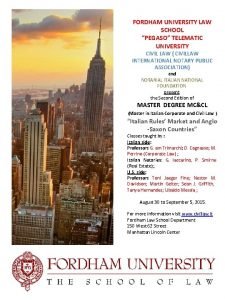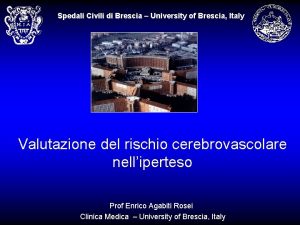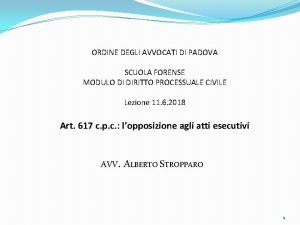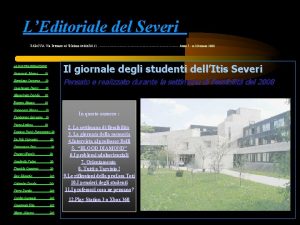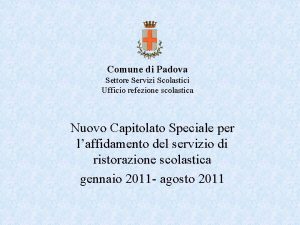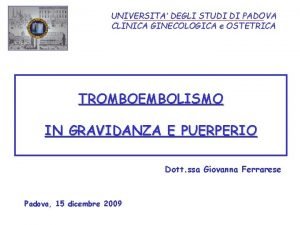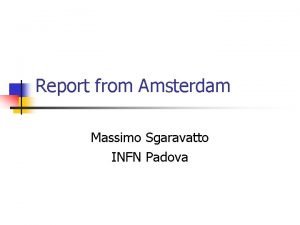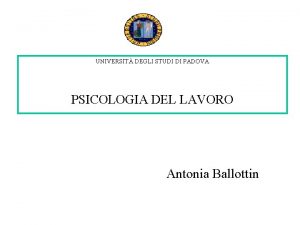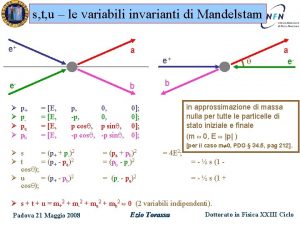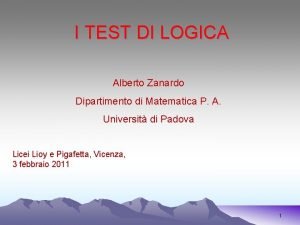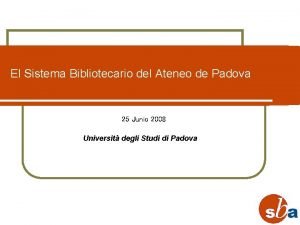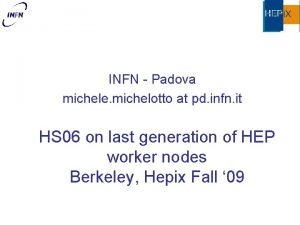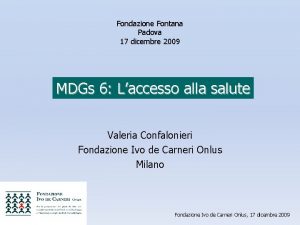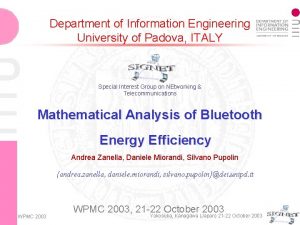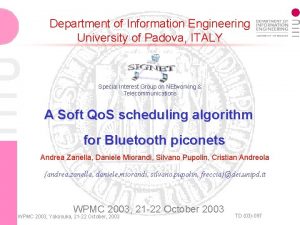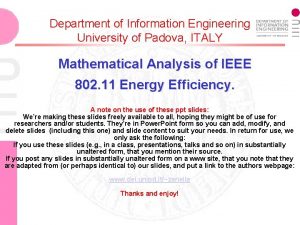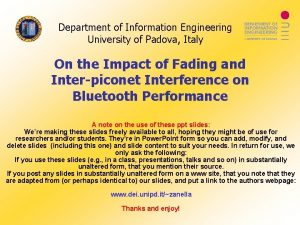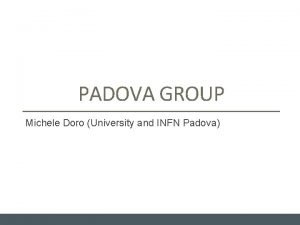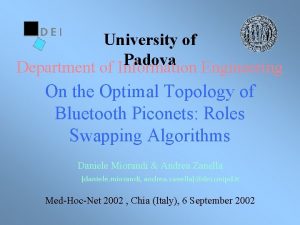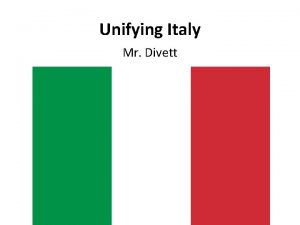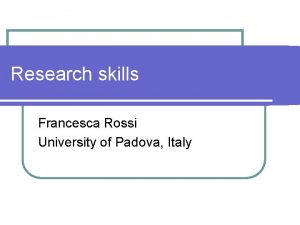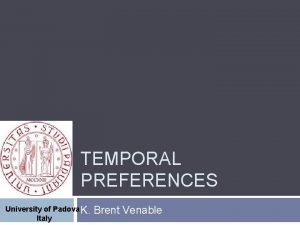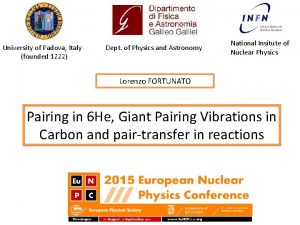Department of Information Engineering University of Padova Italy

































- Slides: 33

Department of Information Engineering University of Padova, Italy Mathematical Analysis of Bluetooth Energy Efficiency A note on the use of these ppt slides: We’re making these slides freely available to all, hoping they might be of use for researchers and/or students. They’re in Power. Point form so you can add, modify, and delete slides (including this one) and slide content to suit your needs. In return for use, we only ask the following: If you use these slides (e. g. , in a class, presentations, talks and so on) in substantially unaltered form, that you mention their source. If you post any slides in substantially unaltered form on a www site, that you note that they are adapted from (or perhaps identical to) our slides, and put a link to the authors webpage: www. dei. unipd. it/~zanella COST 273, Barcelona, 15 -17 January, 2003 Thanks and enjoy!

Department of Information Engineering University of Padova, Italy Mathematical Analysis of Bluetooth Energy Efficiency Andrea Zanella, Silvano Pupolin {zanella, pupolin}@dei. unipd. it COST 273 Barcelona, 15 -17 January 2003 COST 273, Barcelona, 15 -17 January, 2003

Outline of the contents Motivations & Purposes Bluetooth reception mechanism System Model Results Conclusions COST 273, Barcelona, 15 -17 January, 2003 TD (03)-028

What & Why… Motivations & Purposes COST 273, Barcelona, 15 -17 January, 2003 TD (03)-028

Motivations Bluetooth was designed to be integrated in portable battery driven electronic devices Energy Saving is a key issue! Bluetooth Baseband aims to achieve high energy efficiency: Units periodically scan radio channel for valid packets Scanning takes just the time for a valid packet to be recognized Units that are not addressed by any valid packet are active for less than 10% of the time COST 273, Barcelona, 15 -17 January, 2003 TD (03)-028

Aims of the work Although reception mechanism is well defined, many aspects still need to be investigated: What’s the energy efficiency achieved by multi-slot packets? What’s the role plaid by the receiver-correlator margin parameter? What’s the amount of energy drained by Master and Slave units? Our aim is to provide answers to such questions! How? Capture system dynamic by means of a FSMC Define appropriate reward functions (Data, Energy, Time) Resort to renewal reward analysis to compute system performance COST 273, Barcelona, 15 -17 January, 2003 TD (03)-028

What standard says… Bluetooth reception mechanism COST 273, Barcelona, 15 -17 January, 2003 TD (03)-028

Access Code field PAYL Access Code (AC) AC field is used for synchronization and piconet identification All packet exchanged in a piconet have same AC Bluetooth receiver correlates the incoming bit stream against the expected synchronization word: AC is recognized if correlator output exceeds a given threshold AC does check HEAD is received AC does NOT check reception stops and pck is immediately discarded COST 273, Barcelona, 15 -17 January, 2003 TD (03)-028

Receiver-Correlator Margin S: Receiver–correlator margin Determines the selectivity of the receiver with respect to packets containing errors Low S strong selectivity risk of dropping packets that could be successfully recovered High S weak selectivity risk of receiving an entire packet that contains unrecoverable errors COST 273, Barcelona, 15 -17 January, 2003 TD (03)-028

Packet HEADer field PAYL Packet Header (HEAD) Contains: Destination address Packet type ARQN flags: used for piggy-backing ACK information Header checksum field (HEC): used to check HEAD integrity HEC does check PAYL is received HEC does NOT check reception stops and pck is immediately discarded COST 273, Barcelona, 15 -17 January, 2003 TD (03)-028

Packet PAYLoad field PAYL Payload (PAYL) DH: High capacity unprotected packet types DM: Medium capacity FEC protected packet types (15, 10) Hamming code CRC field is used to check PAYL integrity: CRC does check positive acknowledged is return (piggy-back) CRC does NOT check negative acknowledged is return (piggy-back) COST 273, Barcelona, 15 -17 January, 2003 TD (03)-028

Conditioned probabilities Receiver. Correlator Margin (S) AC 72 bits HEAD 54 bits 2 -time bit rep. (1/3 FEC) DHn: Unprotected DMn: (15, 10) Hamming FEC PAYLOAD CRC h=220 2745 bits 0: BER COST 273, Barcelona, 15 -17 January, 2003 TD (03)-028

Retransmissions NAK MASTER ACK SLAVE A X B X DPCK Automatic Retransmission Query (ARQ): Each data packet is transmitted and retransmitted until positive acknowledge is returned by the destination Negative acknowledgement is implicitly assumed! Errors on return packet determine transmission of duplicate packets Slave filters out duplicate packets by checking their sequence number Slave never transmits duplicate packets! Slave can transmit when it receives a Master packet piggy-backs the ACK/NACK for previous Slave transmission Slave retransmits only when needed! COST 273, Barcelona, 15 -17 January, 2003 TD (03)-028

Mathematical Analysis System Model COST 273, Barcelona, 15 -17 January, 2003 TD (03)-028

Mathematical Model System dynamic can be modelled by means of a discrete time independent process {en} with state space E Each state corresponds to a specific system behaviour For each state Ej E, we define the following reward functions Dj(x)= Average amount of data delivered by unit x {M, S} Wj(x)= Average amount of energy consumed by unit x {M, S} Tj= Average amount of time spent in state Ej Denoting by j the probability of event Ej, the average amount of reward earned in state Ej is given by: COST 273, Barcelona, 15 -17 January, 2003 TD (03)-028

System Dynamic We need to determine: State space E System behaviour in each Ej E System dynamic depends on the packet reception events that occur at Slave and Master units Let us first focus on events that may occur during the reception of a single packet COST 273, Barcelona, 15 -17 January, 2003 TD (03)-028

Packet reception events Let us define the following basic packet reception events ACer: AC does not check HECer: AC does check & HEAD does not Packet is recognized but PAYL contains unrecoverable errors CRCok: AC & HEAD & PAYL do check Packet is not recognized CRCer: AC & HEAD do check, PAYL does not Packet is not recognized Packet is successfully received Furthermore, we introduce the following notation Recognition Error: RECer={ACer or HECer} Recognition OK: RECok={CRCer or CRCok} COST 273, Barcelona, 15 -17 January, 2003 TD (03)-028

Basic reception events (1) Looking at the reception status of both the downlink (master to slave) and uplink (slave to master) packets, we can identify four basic reception events r 1: both downlink and uplink packet are recognized by the slave and master unit, respectively r 2: downlink packet is not recognized by the slave unit (uplink packet is not returned) r 3: downlink packet is recognized by the slave unit, but PAYL is not correct, uplink packet is not recognized by the master unit r 4: downlink packet is successfully received by the slave unit, uplink packet is not recognized by the master unit COST 273, Barcelona, 15 -17 January, 2003 TD (03)-028

Basic reception events (2) Note that, Basic events are disjoint: Their probabilities adds to one: The occurrence of each basic event determines a specific system dynamic for a given number of steps We define a state Ei to each basic event ri: ri Ei State Ei collects the system dynamic after the occurrence of the basic event ri COST 273, Barcelona, 15 -17 January, 2003 TD (03)-028

Notations Let us introduce some notation: Dxn= downlink (Master to Slave) packet type, n=1, 3, 5 Dym= uplink (Slave to Master) packet type, L(Dxn) = number of data bits carried by the Dxn packet type w. TX(X)= amount of power consumed by transmitting packet field X w. RX(X)= amount of power consumed by receiving packet field X w 0= average amount of power consumed by the receiving unit in m=1, 3, 5 case the incoming packet is not recognized, i. e. , RECer occurs: COST 273, Barcelona, 15 -17 January, 2003 TD (03)-028

System Dynamic: E 1 MASTER Transmission Reception SLAVE T 1 Rewards earned in state E 1 are given by: Time spent is E 1 Energy consumed by Master Energy consumed by Slave Data delivered by Master Data delivered by Slave COST 273, Barcelona, 15 -17 January, 2003 TD (03)-028

System Dynamic: E 2 MASTER Transmission Reception SLAVE T 2 Rewards earned in state E 2 are given by: Time spent is E 2 Energy consumed by Master Energy consumed by Slave Data delivered by Master Data delivered by Slave COST 273, Barcelona, 15 -17 January, 2003 TD (03)-028

System Dynamic: E 3 MASTER Transmission Reception SLAVE T 3 Rewards earned in state E 3 are given by: Time spent is E 3 Energy consumed by Master Energy consumed by Slave Data delivered by Master Data delivered by Slave COST 273, Barcelona, 15 -17 January, 2003 TD (03)-028

System Dynamic: E 4 T 4 State E 4 is entered when r 4 event occurs: Downlink packet is perfectly received, while uplink packet is not recognized Master keeps retransmitting duplicate pcks until a return pck is recognized Slave listens only for AC and HEAD fields of duplicate packets and returns an uplink packet for each duplicate packet it recognizes State E 4 is left when r 1 event occurs: Both downlink and uplink packets are recognized by the respective units COST 273, Barcelona, 15 -17 January, 2003 TD (03)-028

Performance Analysis Results COST 273, Barcelona, 15 -17 January, 2003 TD (03)-028

Performance Indexes From the renewal reward analysis, we can evaluate the following performance indexes Goodput: G Amount of data successfully delivered per unit of time Energy Efficiency: Amount of data successfully delivered per unit of energy consumed COST 273, Barcelona, 15 -17 January, 2003 TD (03)-028

AWGN channel: M>S Asymmetric connection: M>S Data flows from Master to Slave SNRd. B < 14, G 0 SNRd. B=14 18, DMn outperforms DHn SNRd. B>18, DHn achieves better G Energy efficiency curves resemble Goodput curves However, performance gap between Dx 5 and Dx 3 pck types is reduced COST 273, Barcelona, 15 -17 January, 2003 TD (03)-028

AWGN channel: S>M Asymmetric connection: S>M Swapping Master and Slave role: Data flows from Slave to Master DM 5 & DM 3 Goodput increases up to 15 % Other pck types do not improve, but neither lose performance… Energy efficiency improvement for DM 5 & Dm 3 pcks is up to 22 % However, for greater SNR values, performance improvement is lower… COST 273, Barcelona, 15 -17 January, 2003 TD (03)-028

Rayleigh channel: M>S Performance in Rayleigh channels is drastically reduced! SNRd. B<14, G 0 SNRd. B<18, DMn & DHn types achieve similar performance Saturation is achieved for SNRd. B>40 Energy efficiency curves resemble Goodput curves Curves shape is smoother than for AWGN COST 273, Barcelona, 15 -17 January, 2003 TD (03)-028

Rayleigh channel: S>M For Rayleigh fading channel, S>M configuration is much better performing than M>S configuration, for almost all the packet types DM 5 & DM 3 Goodput increases up to 55 % DH 5 & DH 3 Goodput increases up to 15 % All the packet types improve energy efficiency performance For DM 5 & DM 3, Δ up to 88 %!!! For DH 5 & DH 3, Δ up to 20 % COST 273, Barcelona, 15 -17 January, 2003 TD (03)-028

Impact of parameter S The receiver correlator margin S has strong impact on system performance G improves for high S values (from 30% up to 230% for SNR d. B=15) improves for DMn and DH 1 types slightly decreases for DH 5 & DH 3 types (less 6 % performance loss) Relaxing AC selectivity is convenient, since G gain is much higher than loss Impact of S, however, rapidly reduces for SNRd. B>15 COST 273, Barcelona, 15 -17 January, 2003 TD (03)-028

Conclusions Average traffic rate shows a tradeoff between different packet types Unprotected and long types yield better Goodput for SNR > 18 For lower SNR, better performance are achieved by short and protected formats Performance gap between protected and unprotected formats is drastically reduced in fading channels Slave to Master configuration yields performance improvement in terms of both Goodput and Energy Efficiency Server (slave) never retransmits pcks that were already received by the client (master) Parameter S may significantly impact on performance Short and Protected packet types improve performance with S Long and Unprotected packet types show less dependence on this parameter Results may be exploited to design energy–efficient algorithms for the piconet management COST 273, Barcelona, 15 -17 January, 2003 TD (03)-028

That’s all! Thanks for you attention! COST 273, Barcelona, 15 -17 January, 2003 TD (03)-028
 Department of information engineering university of padova
Department of information engineering university of padova Department of information engineering university of padova
Department of information engineering university of padova University of padova psychology department
University of padova psychology department Information engineering padova
Information engineering padova University of sargodha engineering department
University of sargodha engineering department University of salerno italy
University of salerno italy Pegaso university italy
Pegaso university italy Brescia university italy
Brescia university italy Ic donatello padova
Ic donatello padova Organigramma comune di padova
Organigramma comune di padova Scuola forense padova
Scuola forense padova Via pettinati 46 padova
Via pettinati 46 padova Introduzione al vangelo di luca
Introduzione al vangelo di luca Iv istituto comprensivo padova
Iv istituto comprensivo padova Iniziazione cristiana padova
Iniziazione cristiana padova Servizi scolastici padova
Servizi scolastici padova Clinica neurologica padova
Clinica neurologica padova Dai ragazzi padova
Dai ragazzi padova Dai ragazzi padova
Dai ragazzi padova Embricazione eparina coumadin
Embricazione eparina coumadin Moodle psicologia unipd
Moodle psicologia unipd Infn padova
Infn padova Amici dei popoli padova
Amici dei popoli padova Psicologia del lavoro padova
Psicologia del lavoro padova Invarianti di mandelstam
Invarianti di mandelstam Zanardo pediatra padova
Zanardo pediatra padova Sistema bibliotecario ateneo padova
Sistema bibliotecario ateneo padova Burchiello padova
Burchiello padova Cinel padova
Cinel padova Palestra happy feet padova
Palestra happy feet padova Soft city padova
Soft city padova Pd infn
Pd infn Fondazione fontana padova
Fondazione fontana padova Student storage padova
Student storage padova






